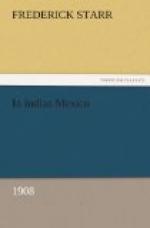slung across the streams, for passing cargoes at high
water. At one place was a fine display of basaltic
columns, the position of which was horizontal, the
flow having come up as a sheet injected from below,
and not as a surface out-flow, where the jointage
would have been vertical. Finally, leaving this
beautiful ravine, we made a rapid ascent, passing a
little village consisting almost wholly of a school,
noisy with study, and a church, with a separate square
tower. Shortly after reaching the summit, and
dipping slightly, we found Tlacuilotepec. It is
not a large town. At its center mestizo,
it has charge of several indian villages. We had
been referred for information concerning surviving
paganism to a Senor Martinez. We were interested
in finding that the presidente of the town
was a brother of this gentleman, and that both were
Protestants. We were received with great cordiality,
not only on account of our official introduction,
but also because we brought an unofficial introduction
from Protestant friends. Two charming beds were
arranged in the little meeting-place in Senor Martinez’s
own house, and two others, almost as good, were secured
for the others of the party, in the little meson
of the village. As we chatted, we were refreshed
with a delicious orange-wine, which is made here,
and during our days spent with Don Quirino, we had
meals fit for a king. The indians under his charge
are Otomis, and in one little village, Santa Maria,
Totonac. When we came to inquire regarding the
pagan practice for which we were searching, we learned
that it was peculiar to the Otomis, and formed their
annual costumbre—custom. They
believe that Montezuma is to come again. Meantime,
from him come health, crops, and all good things.
Their costumbre is a feast given in his honor,
of which he is believed to partake. A jacal—hut—is
prepared in a retired spot; a table is constructed
full length of the house within, and upon this a feast
is spread of which all partake.
Upon this table they place many munecos of paper; formerly these were made of the bark paper, but they are now made of ordinary paper bought in the stores. There may be so many of these that they cover the table an inch or two thick. The feasters shove money, usually small pieces of silver, beneath these figures. They then kill turkeys and hens and chickens, and sprinkle the blood from the headless bodies over the munecos. This they do that Montezuma may be propitiated, and give them what they desire; the money and the munecos, sprinkled with blood, are left upon the table after the feast, the former being stolen by passing mestizos.




